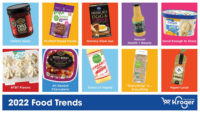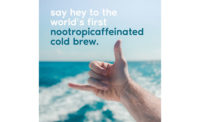Trend Predictions Provide New Insights to Consumer Thinking
Brands need to be flexible in action and open in spirit to connect with consumers, while also taking full advantage of rapidly emerging technological opportunities

“Redefining Value” heads Innova Market Insights’ Top Ten Trends for 2023, as consumers adapt to a global cost-of-living crisis in the face of economic and political volatility. With budgets stretched and supplies under strain, brands need to be flexible in action and open in spirit to connect with consumers, while also taking full advantage of rapidly emerging technological opportunities.
The eagerly awaited annual trends from food innovation and insight specialist Innova are based on wide-ranging global consumer surveys. Coupled with comprehensive market and new product data, they reveal not only what is driving consumer decisions now, but also ways in which brands and innovators can successfully adapt to future realities.
Over the last year, cost and value for money have become more important to more than half of food and beverage consumers worldwide. Today’s shoppers are increasingly exploring money-saving strategies, such as choosing lower cost items and cooking from scratch. But they remain determined to sample new experiences, ensure personal wellbeing and support planetary health. There is more pressure on brands and manufacturers to deliver value while still meeting these wider public expectations.
“Redefining value throughout the food and beverage industry will lead in 2023 as consumers seek brands that listen, understand and respond to their core values. They want brands that provide quality, trust and confidence via their product formulations, communications and wider sustainability actions,” highlights Lu Ann Williams, global insights director at Innova Market Insights.
In addition to a heightened demand for competitive pricing, consumers have told Innova they still seek nutritional value and expect a continued shared responsibility for environmental security. Meanwhile, younger generations who have grown up in an inclusive digital age are gaining greater influence, changing markets and creating new opportunities. Against that complex backdrop, here’s a taste of what Innova’s Top Ten Trends show is in store for the food and beverage industry in 2023:
1. Redefining Value
Brands, innovators, producers and consumers are wrestling with rising costs and greater instability. Combating this requires a deep understanding of where consumers draw the line on compromise. Strategies such as simple price increases, or flexible ingredient lists to cope with supply chain fluctuations, can work in the short term. However, brands need to be open in their communication and clearly show the benefits they are bringing.
Despite political and economic volatility becoming the second biggest concern for consumers in 2022, the health of the planet remains the top global issue and financial pressures are leading to an increase in eco-friendly behaviors. Consumers tell Innova they have reduced food waste and upcycled or recycled more as part of their belt-tightening. As the cost-of-living crisis continues, brands can achieve success through actions that combine economic benefits with clear health and sustainability goals.
2. Affordable Nutrition
>Over the past 12 months, 62% of consumers have reported a noticeable rise in the cost of their food and beverages. As a result, they are turning their attention to simple but nutritious goods that are affordable. Key behaviors include buying in bulk, opting for private labels, cooking from scratch, reducing spending on luxury items and purchasing fewer items.
Consumers are actively looking for affordable ways to maintain a healthy diet, offering brands many opportunities to test their capabilities to new limits. To meet the nutritional, environmental and economic demands of consumers, manufacturers must innovate to extract maximum value from raw materials and the production process.
3. Generational Push
Younger consumers, raised in an interactive digital world, are creating trends and defining what markets should be providing. For Gen Z and Millennials, food and brand choices are important signifiers of lifestyle, beliefs and values. These demographics have a strong voice and are used to sharing their views openly and widely.
While health is an increasingly important purchase driver – as it also is across older generations – novel and international flavors are winning the hearts of a young and experimental audience. These consumers embrace the new and different, while being extremely responsive to positive engagement from brands.
4. Plant-Based: Unlocking a New Narrative
The rapid rise of the plant-based sector has, almost inevitably, hit some roadblocks, necessitating a refocusing on consumer demands for high quality, flavorsome products. No longer merely a mimic, green gastronomy will blossom as a stand-alone sector in 2023, giving brands significant opportunities to diversify and expand. Consumers still want to see improvements in taste and texture, but there is a huge appetite for culinary creativity and worldwide flavor profiles.
Two-thirds of respondents to Innova’s global survey expressed a desire to try plant-based versions of traditional, local cuisines. The industry is responding with a large increase in ready-meal offerings, while there is great scope for expansion into meal kits and inventive recipe combinations. Interest in underused ingredients is also growing, creating opportunities to introduce variation in flavor and nutrition while simultaneously addressing supply concerns.
5. Farming the Future
>Public curiosity for innovative technologies such as vertical and regenerative farming is increasing. As well as helping to maximize flavor, nutrition and yield, these advances can win consumer support where they are shown to improve the quality and sustainability of global food production.
Today’s consumer is increasingly invested in the source of food as it ties in with major global concerns of health, sustainability and waste. The welfare of agricultural workers is equally important, with 65% of respondents to Innova’s surveys agreeing they would rather buy fruit and vegetables from farmer’s markets than large stores. Brands need to demonstrate how novel production techniques are benefiting farmers, people and the planet.
6. Quick Quality
The cooking from scratch trend that blossomed during the pandemic remains popular and now must fit in with “back to normal” routines. There is a demand for time-saving convenience to combine with fresh produce and recipes with flavorful impact, adding value as well as lending a helping hand. Quality of ingredients and engagement with creative home cooking through meal kit guidance add an elevated experience for consumers who are keen to maintain or extend their culinary range.
7. Devouring Digital
The digital world is evolving into a bigger, faster, more immersive and interconnected entity, combining the virtual with reality and blurring the boundary between. The endless possibilities to enhance real life with digital experiences are embraced by early adopters and ready for a wider audience. Forward-looking food and beverage brands are now integrating themselves into an arena bursting with opportunities, such as ultra-personalized nutrition, abstract innovations or new platforms to connect with the consumer.
8. Revenge Spending
Even in strained economic times – and in part to make up for opportunities lost during the pandemic – consumers are looking to indulge in enjoyable experiences. Mood lifting and intriguing sensations are being prioritized with interesting collaborations and limited editions giving new life to old favorites. Tapping into the public need for discoveries that uplift and surprise can change perceptions and re-position brands, especially with younger consumers.
9. Unpuzzle health
On-pack messaging is a go-to source for consumers keen to know about the health and nutritional value of a product. Yet finding the right balance is key for businesses navigating a complex and ever-changing health communication landscape. To reinforce belief in health claims, that information needs to be clear, to the point, backed by trusted certifications and reflected in experience. While recognition from respected organizations helps simplify messaging and build trust, oversimplification can cause consumers to get suspicious.
10. Positively Imperfect
There is wider understanding of the complexities involved in achieving sustainability. Consumers know it is not a simple question of good and bad, but more a prioritization of what creates optimal results. Compromises made en route to a positive goal are more likely to be accepted and forgiven if coupled with honesty and an explanation of aims. Brands are not expected to get everything right all the time and can expect a more sympathetic response if the focus remains on action towards long term improvement.
Looking for a reprint of this article?
From high-res PDFs to custom plaques, order your copy today!





